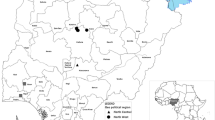Abstract
Both female castes of the honeybee (Apis mellifera L.) synthesize hydroxylated 2(E)-decenoic acids in their mandibular glands. Queens produce 9-hydroxy-2(E)-decenoic acid as part of their primer pheromone, while workers produce the regioisomeric 10-hydroxy acid, probably as a larval food source and an antiseptic secretion. Both workers and queens are biosynthetically competent to produce the other caste's dominant hydroxylated compound, as both isomers can be detected in queens and workers. We investigated the source of the caste-determined regioselectivity of hydroxy acid biosynthesis by investigating the production and interconversion of these compounds in isolated worker honeybee mandibular glands with specifically deuterated precursors. Gas chromatographic-mass spectroscopic identification of the labeled product indicates that octadecanoic acid is converted into 10-hydroxy-2(E)-decenoic acid with higher efficiency than either hexadecanoic or decanoic acids. 10-Hydroxydecanoic acid is readily converted into 10-hydroxy-2(E)-decenoic acid as expected in the β-oxidation process. The saturated and unsaturated 10-hydroxy acids are oxidized to the corresponding ten carbon diacids.
Similar content being viewed by others
References
Babler, J.H., andCoghlan, M.J. 1979. A facile method for monoacetylation of symmetrical diols: Application to the total synthesis ofZ-8-dodecenyl acetate, the sex attractant of the oriental fruit moth.Tetrahedron Lett. 1979:1971–1974. No. 22.
Blum, M.S., Novak, A.F., andTaber, S., III. 1959. 10-Hydroxy Δ2-decenoic acid, an antibiotic found in royal jelly.Science 130:452–453.
Boch, R., Shearer, D.A., andShuel, R.W. 1979. Octanoic and other volatile acids in the mandibular glands of the honeybee and in royal jelly.J. Agric. Res. 18:250–252.
Chiron, R. 1982. New synthesis of royal jelly acid.J. Chem. Ecol. 8:709–713.
Corey, E.J., andSchmidt, G. 1979. Useful procedures for the oxidation of alcohols involving pyridinium dichromate in aprotic media.Tetrahedron Lett. 1979:399–402. No. 5.
Crewe, R.M. 1982. Compositional variability: The key to social signals produced by the honeybee mandibular glands, pp. 318–332,in M.D. Breed, C.D. Michener and H.E. Evans (eds.). The Biology of Social Insects. Westview Press, Boulder, Colorado.
Devore, J.L. 1991. Probability and Statistics for Engineering and the Sciences, 3rd ed. Brooks/Cole Pub. Co., Pacific Grove, California.
Graham, S.H., andWilliams, A.J.S. 1966. Alkylidenecyclobutanes. Part II. The oxidation of benzylidenecyclobutane and of bis-(p-methoxyphenyl)methylenecyclobutane.J. Chem. Soc. (C) 1966:655–660. Vol. 5.
Johnston, N.C., Law, J.H., andWeaver, N. 1965. Metabolism of 9-ketodec-2-enoic acid by worker honeybees (Apis mellifera L.)Biochemistry 4:1615–1621.
Jurenka, R.A., andRoelofs, W.L. 1993. Biosynthesis and endocrine regulation of fatty acid derived sex pheromones in moths, pp. 353–388.in D.W. Stanley-Samuelson and D.R. Nelson (eds.). Insect Lipids: Chemistry, Biochemistry and Biology. University of Nebraska Press, Lincoln and London.
Kaatz, H.H., Hildebrandt, H., andEngels, W. 1992. Primer effect of queen pheromone on juvenile hormone biosynthesis in adult worker honey bees.J. Comp. Physiol. (B) 162:588–592.
Kandil, A.A., andSlessor, K.N. 1985. Enantiomeric synthesis of 9-hydroxy (E)-2-decenoic acid, a queen bee pheromone.Can. J. Chem. 61:1166–1168.
Plettner, E., Slessor, K.N., Winston, M.L., Robinson, G.E., andPage, R.E. 1993. Mandibular gland components and ovarian development as measures of caste differentiation in the honey bee (Apis mellifera L.)J. Insect Physiol. 39:235–240.
Ruttner, F., Koeninger, N., andVeith, H.J. 1976. Queen substance bei eierlegenden Arbeiterinnen der Honigbiene (Apis mellifera L.)Naturwissenschaften 63:434–435.
Slessor, K.N., Kaminski, L.-A., King, G.G.S., Borden, J.H., andWinston, M.L. 1988. The semiochemical basis of the retinue responses to the queen honey bee.Nature 332:354–356.
Slessor, K.N., Kaminski, L.-A., King, G.G.S., andWinston, M.L. 1990. Semiochemicals of the honey bee queen mandibular glands.J. Chem. Ecol. 16:851–860.
Weaver, N., Johnston, N.C., Benjamin, R., andLaw, J.H. 1968. Novel fatty acids from the royal jelly of honeybees (Apis mellifera L.)Lipids 3:535–538.
Winston, M.L. 1987. The Biology of the Honey Bee, 1st ed. Harvard University Press, Cambridge, Massachusetts.
Winston, M.L., andSlessor, K.N. 1992. An essence of royalty: Honey bee queen pheromone.Am. Sci. 80:374–385.
Winston, M.L., Higo, H.A., andSlessor, K.N. 1990. The effect of various dosages of queen mandibular pheromone on the inhibition of queen rearing in the honey bee (Hymenoptera: Apidea).Ann. Entomol. Soc. Am. 83:234–238.
Author information
Authors and Affiliations
Rights and permissions
About this article
Cite this article
Plettner, E., Sutherland, G.R.J., Slessor, K.N. et al. Why not be a queen? Regioselectivity in mandibular secretions of honeybee castes. J Chem Ecol 21, 1017–1029 (1995). https://doi.org/10.1007/BF02033805
Received:
Accepted:
Issue Date:
DOI: https://doi.org/10.1007/BF02033805




